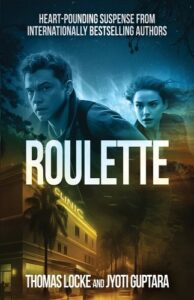Many thanks to Jyoti Guptara and Thomas Locke for kindly offering a conversation about their new thriller, Roulette.
Jyoti Guptara: Thomas, remember when you visited me at the UN in Geneva? You arrived with this brilliant story seed: “What appears to be a simple case of overdose turns into an ER nightmare. Patients seem to be suffering symptoms from multiple drugs. None are detectable.” I can’t believe I’ve never asked you, but where did the idea come from?
Thomas Locke: It all started with a second bottle of wine.
A family we’ve known since forever were leaving Florida. The husband, a surgeon, had flown with their two daughters to house-shop in Chicago. (For the record, that would never happen with my wife. Buy a house without her? Ha. Never, never, never.) The wife, head of the ER department at our local hospital, was on duty and could not get away. (Never, never, never.) They were all sad over the change, but the parents had both been offered places at Chicago’s teaching hospital, and the girls were moving closer to their extended family. So we invited our sad and solitary friend and mother out for a medicinal meal.
Over the second bottle, at a question from my wife, our friend started talking about every ER doctor’s worst nightmare:
A new designer drug.
Totally off the books. No idea what symptoms would mark the patient’s decline into a bad journey. So when the patient shows up, already off the rails, what are they supposed to do? Successful treatment starts with knowing what they’re facing. In such cases, though, there is no history. No signs to look out for. No red lights. Nada.
Jyoti: Oh, wow, so this idea came from an actual conversation with an Emergency Room professional… Did your friend ever experience the arrival of a new designer drug?
Thomas: Yes, early in our friend’s career, she had been at the forefront of just such an event. According to her, no one who had witnessed a PCP abuser go off the deep end ever forgot the experience. Six professionals often were required to hold them down. When the first cases began appearing in the early nineties, the ER staff had no idea what they were dealing with. The unfocused rage and the super-human strength were unlike any other drug reaction they had ever seen. And suddenly it was everywhere. Toxicologists and pathologists around the country were comparing these freakish episodes. Everyone in ER work was accustomed to securing agitated patients. This was something else entirely, and the bloodwork was unlike anything they had ever seen. They knew they were observing the impact of a drug that could not be identified. It took almost a year before the data was collated and the substance named as Phencycledine, also known as PCP or angle dust. It took another fourteen months before the drug was ranked among the highest-danger category of illegal narcotics.
The three of us lingered over coffee, knowing it was not just the end of another fine meal, but a turning of life’s pages. They were leaving for Chicago. And what my wife and I had decided not to share was that we were also departing. Our own home was on the market. My wife’s new work had us moving to England.
At that point, our friend confessed the secret fear normally shared only with other ER doctors during late-night gatherings.
The next designer drug? It causes a genetic mutation.
Jyoti: That sounds awful. But I know very little about medicine. Why are ER doctors so nervous about a designer drug that causes a genetic mutation?
Thomas: That would be something the medical community can’t correct, even after it has been fully ID’d. All they can do is treat the worst symptoms and reduce the temporary side effects. And all the while, they know the patient will return over and over again. Because with this new drug, the high keeps coming back. Each time, the risk of life-threatening side effects returns.
These were the whispered concerns that would not go away, she told us. The risk of being made helpless by what they could not ever fully treat.
Jyoti: Working on our new story, we needed a hook, the big issue that brought the whole thing together. When did you have this conversation?
Thomas: Three weeks later, you and I met in Geneva and began sketching out what we wanted to see happen in our new story. Ideas became characters, plotlines, questions. It seems so simple now, looking back and seeing this assortment of concepts and goals, and then in that special moment, recalling the dinner with our friend the ER doctor. And seeing all the swirling designs and questions and aims all coalesce into Roulette.
***


















